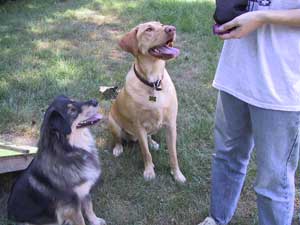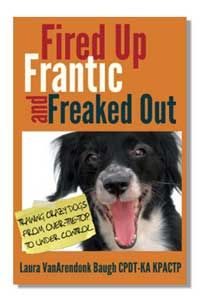Encouraging creativity—in all species
Clicker trainers know that one of the benefits of clicker training is that it fosters creativity in the learner. A clicker trained dog learns to use problem-solving skills with the hope of finding the behavior that will earn a reward. Did you know that clicker training also fosters creativity in the teacher? One of the things that KPA faculty member Laura VanArendonk Baugh loves about operant conditioning is that it allows her to use her own creativity to teach in new ways, whether the learner is canine or human. Through her articles, her bestselling book Fired Up, Frantic, and Freaked Out: Training the Crazy Dog from Over-the-Top to Under Control, her KPA workshops, and her upcoming debut as a speaker at ClickerExpo 2014, Laura is changing the way people think about both canine and human behavior.

How did you get started in dog training?
I had always wanted to work with animals. I showed horses when I was a kid and did Dog 4H and similar activities. I went to school for a "real job," graduating with two majors and a minor, and then decided to go into dog training instead.
You are a crossover trainer. What prompted you to cross over to positive training methods?
In part, I was prepared for it by my dog Chaucer (whose picture is in the dedication of Fired Up, Frantic, and Freaked Out). She started as a mildly reactive dog and, despite everything I knew about punishing bad behavior, she kept getting worse. It was inexplicable how, despite my stern voice and training-collar pops, Chaucer not only kept performing the unwanted behavior but did more of it! Looking back, this is absurdly obvious, but it was very frustrating at the time.
Then I started learning about lure and reward training, which was way ahead of the Koehler methods I'd been taught. I learned about clicker training a bit on the side, and was told it was "cool but harder." The science of it made a lot of sense, though, and I was drawn to that. I tried a little bit of clicking with Chaucer, inventing for us what is now known as the "look at that game" (certainly not invented solely by me!), and it worked. Within minutes. After that kind of early reinforcement, I couldn't stop.
What fascinates you most about clicker training?
The sheer power of it—it just works. All the time. Any time it's not working, it's a mistake in execution, not a problem of concept. Clicker training has changed how I look at the learner, too. When a dog didn't respond to my previous methods, it was a stubborn dog. When a dog doesn't respond now, I look at the bigger picture. I don't find many stubborn dogs anymore!
How has the dog training world changed since you began training 15 years ago?
Fifteen years ago my biggest challenges were convincing owners to use treats and flat-buckle collars, and not to hit a dog in discipline. Now I very, very rarely have a client who doesn't want to use food. More clients are asking about my credentials, while fifteen years ago there wasn't really an option for certified trainers.
On the other hand, the proliferation of websites and television shows makes it as easy to spread bad information as good. So while the word is definitely out there, we have to show why one approach is more valid than another.
It's been exactly one year since Karen Pryor Clicker Training introduced your new book Fired Up, Frantic, and Freaked Out. What prompted you to write this book and what do you hope people get out of it?

The book is written for the frustrated pet owner. There was a lot of great information circulating for professionals, but in my experience with "average" pet lovers (as distinct from sports enthusiasts and serious hobby trainers), relatively little of that information was trickling down to them. I wanted an entry-level guide to clicker training for reactivity and excitement, something very accessible to people without a lot of background in the field.
Every time I see a review that criticizes the book as "simplistic," I take that as a tiny compliment. It's supposed to be simple! I'm thrilled that so much of the professional community has welcomed my book; that was more than I expected.
When people read the book, I want them to gain hope that their dogs' behavior is rational and changeable, not incomprehensible or a lost cause. I hope that they understand that in the long run baby steps are faster than forward leaps, and that they will see steady progress if they take it slow.
What are the key things that owners of fearful, excited, or reactive dogs should keep in mind?
Dogs aren't happy being afraid or snarky. No one wants to live like that! When presented with a reliable, comfortable alternative, most dogs are going to take it. Our job is to make that alternative feel possible and safe.
You have to start outside of the emotional reaction. Teach and reinforce coping mechanisms where they aren't needed, so that the dog has a reason to believe in them when they are needed. Trying to calm a dog in the middle of an episode is much more difficult for both ends of the leash.
What is your advice for new dog owners?
Socialize! And, teach good behaviors before you need them. You don't need to wait after adopting a dog to start training, as was recommended long ago with more punitive training methods. Remember, good training is part of the relationship, teaching the dog that his new people are reliable, safe, and really fun to work with.
I share with clients a sentence that could put me out of business (in a good way):
"I waste very little time telling my dog what not to do; instead, and more efficiently, I tell him what to do and make sure it's worth his while to remember."
What three behaviors would you like to see every dog owner teach his or her dog?

Wow, this can vary by individual need, and I could argue myself into a lot of different positions! But these three are important:
A nose target—because you can use a really fluent target to fudge so many other behaviors that you haven't fully trained. Recall? Come touch my hand. Leash manners? Touch my hand next to my leg. Nail trim, temperature-taking, shots in rear leg? Touch my hand repeatedly for high reinforcement. I'd rather train everything, of course, but in a pinch a nose target can stand in for a lot.
A recall—because a recall can be life-or-death for a dog that has slipped out of the yard or is chasing something into traffic.
To be comfortable and civil around people—because this impacts the dog's entire world and experience. Dogs that are not fun to be with are shut away from visitors, receive less family time, and don't go out much, resulting in a limited life and worsening behavior. This behavior can be another life-saver.
How should someone pick a dog trainer?
First, I'm obviously a big fan of education and accreditation or certification. In my first professional training job, I replaced two people, one of whom didn't like dogs and the other who didn't even have a dog or any intention of having one. Look for a professional who takes the position seriously; you wouldn't hire a doctor or elementary school teacher who didn't have any professional background, would you?
Watch for keywords that might indicate that your prospective trainer is holding on to outdated methods or attitudes. Quite often advice regarding "establishing yourself as the leader" or "creating respect" is code for bullying or intimidating. Dogs, like people, don't like pushy or egocentric leaders. That is not an inherited wolf trait.
In addition to training dogs, as a faculty member with Karen Pryor Academy you also train people to become dog trainers, with an upcoming course starting in February. What is your teaching philosophy and what can your students expect to learn?
I hope to share with students just how awesome and powerful this stuff is, and how it can influence everything we do, not just teaching manners to an adolescent dog. When we learn to see our own behavior in the same way as we see our dogs' behavior, it not only gives us more empathy but allows us to make better training choices for both species.
We are thrilled that you'll be speaking at ClickerExpo this year! Can you share more about what you'll be speaking about?
I am so excited about this. I get to talk about behavior chains, one of my favorite topics, and all the ways to use them to create more reliable behavior or to disrupt unwanted behavior. There's a hands-on Lab to go along with the Session, too. I'm also tackling the thorny topic of corrections in clicker training—wading through interruptions, discipline, punishment, really all of it. I hope you enjoy it!


Post new comment